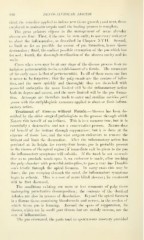Page 492 - My FlipBook
P. 492
490 DENTO-ALVEOLAR ABSCESS.
tiiird, the remedies ;ip])lie(l to induce new tissue orowth ; and next, those
employed to maintain asepsis until the heahng process is complete.
The great primary objects in the management of acute alveolar
abscess are four : First, if the case be seen early, to use every endeavor
to abort the inflammation, as described in Chapter XVII. Second,
to limit as far as possible the extent of pus formation, hence tissue
destruction ; third, the earliest possible evacuation of the pus which has
formed ; fourth, the thorough sterilization of the abscess cavity and its
walls.
Cases when seen may be at any stage of the disease process from an
incipient pericementitis to the establishment of a fistula. The treatment
of the early cases is that of pericementitis. In all of these cases one fact
is never to be forgotten : that the pulp canals are the centres of infec-
tion, and the more quickly and thoroughly they are drenched with
powerful antiseptics the more limited will be the inflammatory action
both in degree and extent, and the more limited will be the pus forma-
tion. Attempts are therefore made to enter and sterilize cavities pari
passu with the antiphlogistic measures applied to abort or limit inflam-
matory action.
Treatment of Abscess without Fistula.—Abscess has been de-
scribed by the older surgical pathologists as the process through which
Nature rids herself of an irritant. This is in a measure true, but it is
essentially a destructive and not a conservative process. Nature does
rid herself of the irritant through suppuration ; but it is done at the
expense of tissue loss, and the wise surgeon endeavors to remove the
irritant and limit the destruction. After the inflammatory action has
persisted at its height for twenty-four hours, pus is probably present
in the tissues of the apical region ; if immediate exit be given to the pus
the inflammatory symptoms will subside. If the tooth be not so sensi-
tive as to preclude touch upon it, an endeavor is made, after washing
the pulp chamber with powerful antiseptics, to pass a very fine Donald-
son's bristle through the apical foramen. In many cases this may be
done; the pus escaping through the canal, the inflammatory symptoms
begin to subside. This is a case of acute blind abscess ; its treatment
will be first discussed.
The conditions existing are more or less remnants of pulp tissue
undergoing putrefactive decomposition ; the contents of the dentinal
tubules are also in process of dissolution. Beyond the apical foramen
is a fibrous tissue containing bloodvessels and nerves, in the meshes of
which tissue pus is forming. Beyond the spots of suppuration, the
tissues, which are in small part fibrous but are mainly osseous, are the
seat of inflammation.
The pus evacuated, the parts tend to spontaneous recovery provided


